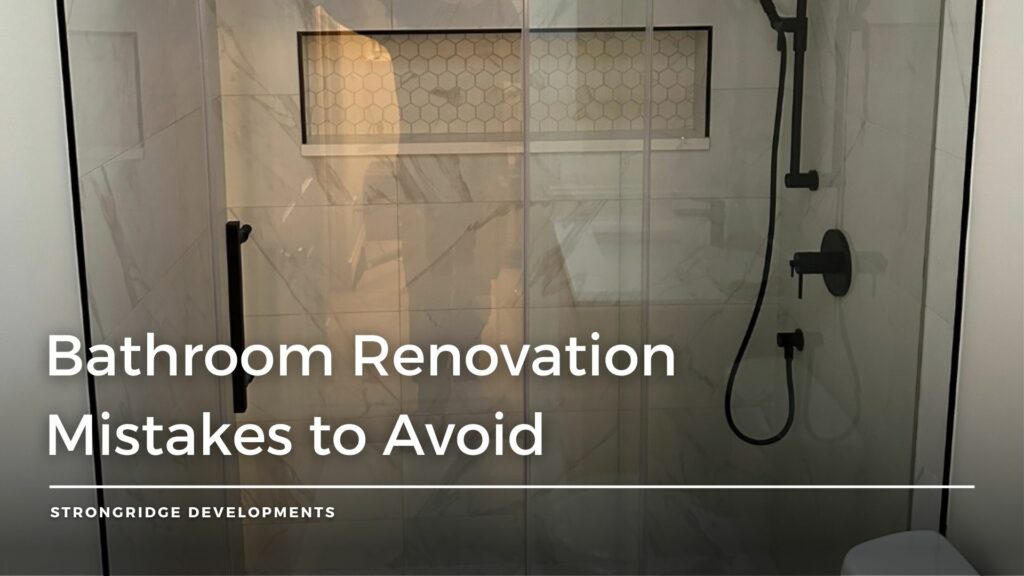Bathroom renovation is a popular home improvement project that can significantly increase the value of your home. Whether you’re looking to make a small update or completely remodel your bathroom, it’s important to avoid common mistakes that can lead to costly and frustrating outcomes.
In this article, we’ll discuss the top mistakes to avoid in bathroom renovation and how to ensure a successful and stress-free remodel.
Mistake #1: Not Having a Clear Plan
One of the biggest mistakes people make when renovating their bathroom is not having a clear plan in place. Without a well-thought-out strategy, you may find yourself making decisions on the fly, which can lead to inconsistencies and overspending. It’s important to have a clear vision of what you want your bathroom to look like before starting the renovation process.
How to Avoid It:
Take the time to plan out the layout, materials, and design elements you want in your new bathroom. This should include everything from the color scheme to the type of fixtures you wish to install. Consider factors such as budget, functionality, and style to create a realistic plan that meets your needs and desires. If you’re unsure, consult with a professional to help you create a detailed plan that will guide you throughout the renovation process. A well-documented plan can also serve as a point of reference when communicating with contractors and suppliers.

Mistake #2: Ignoring the Plumbing and Electrical Work
Many people overlook the importance of plumbing and electrical work when renovating their bathroom. These aspects are crucial for the functionality and safety of your bathroom, and neglecting them can lead to major issues down the line. Incorrectly installed plumbing can result in leaks and water damage, while faulty electrical work can pose serious safety hazards.
How to Avoid It:
Hire a licensed plumber and electrician to handle all the necessary work. It’s important to have a professional assess your bathroom’s plumbing and electrical systems before any renovations begin to ensure they are up to code and can handle any changes or upgrades. Moreover, a professional can provide valuable advice on the most efficient and cost-effective ways to achieve your renovation goals.

Mistake #3: Choosing the Wrong Materials
Selecting the wrong materials for your bathroom can result in costly and unsatisfactory outcomes. It’s crucial to choose materials that are not only visually appealing but also durable and suitable for a bathroom environment. For example, some flooring materials may be prone to slipping when wet, while certain paints might not hold up well in a humid environment.
How to Avoid It:
Do your research and choose materials that are specifically designed for bathroom use. Consider factors such as water resistance, durability, and maintenance before making a decision. It’s also important to consider your budget and choose materials that are within your price range. High-quality materials may come with a higher upfront cost but can save you money in the long run due to their longevity and lower maintenance requirements.

Mistake #4: Not Having Enough Storage Space
Storage is often an afterthought in bathroom renovation projects, but it’s an essential aspect that can greatly impact the functionality and organization of your space. Not having enough storage can lead to clutter and a lack of functionality in your bathroom. In addition to affecting the aesthetics of your bathroom, insufficient storage can make it difficult to find and access your bathroom essentials.
How to Avoid It:
Include storage solutions in your bathroom renovation plan. Think beyond the traditional medicine cabinet and consider options such as built-in shelves, cabinets, and vanity units to maximize storage space while keeping your bathroom organized and clutter-free. Custom storage solutions can be tailored to fit your specific needs and can make efficient use of the available space.

Mistake #5: Forgetting About Ventilation
Proper ventilation is crucial in a bathroom to prevent moisture and mold from building up. Neglecting this aspect can lead to damage to your walls, floors, and fixtures, as well as health issues. A bathroom with poor ventilation can also feel uncomfortable and may have lingering odors.
How to Avoid It:
Include ventilation in your renovation plan. This can be achieved through a bathroom fan or a window that can be opened to allow steam to escape. Make sure to choose a fan that is the appropriate size for your bathroom to ensure proper ventilation. Additionally, consider a fan with a humidity sensor that automatically turns on when moisture levels are high.

Mistake #6: Not Setting a Realistic Budget
Not setting a realistic budget is a common mistake in bathroom renovation projects. Underestimating the costs can lead to unexpected expenses and delays, resulting in a stressful and unsatisfactory renovation experience. Many homeowners forget to account for hidden costs such as waste removal, delivery charges, and potential structural repairs.
How to Avoid It:
Research the costs of materials, labor, and any other expenses that may arise during the renovation process. Set a budget that includes a buffer for unexpected costs and stick to it. If you’re unsure, consult with a professional to help you create a realistic budget for your project. Being transparent about your budget with your contractor can also help to ensure that the project stays on track financially.

Mistake #7: Not Hiring a Professional
While it may be tempting to DIY your bathroom renovation to save money, it’s important to consider the potential consequences of not hiring a professional. A poorly executed renovation can lead to costly repairs and a less than desirable outcome. Additionally, complex renovations often require specialized knowledge and skills that go beyond the abilities of the average homeowner.
How to Avoid It:
Hire a professional renovator to handle your bathroom renovation. They have the expertise and experience to ensure a successful and stress-free remodel. If you’re on a tight budget, consider hiring a professional for the more complex aspects of the renovation, such as plumbing and electrical work, while completing simpler tasks yourself. This approach allows you to maintain control over the project while ensuring that the critical components are done correctly.

Mistake #8: Not Considering Future Needs
When planning a bathroom renovation, it’s important to consider your future needs. Neglecting to do so can result in a bathroom that doesn’t meet your needs and requires additional renovations in the future. For instance, if you plan to stay in your home as you age, incorporating accessibility features now can be more cost-effective than retrofitting later.
How to Avoid It:
Think about your current and future needs when planning your bathroom renovation. Consider factors such as aging in place, growing families, and potential resale value when making decisions about the layout and design of your new bathroom. Features like grab bars, a walk-in shower, and non-slip flooring can make your bathroom safer and more comfortable for everyone.

Mistake #9: Not Communicating with Your Contractor
Effective communication is crucial in any renovation project. Failure to communicate with your contractor can lead to misunderstandings, delays, and unsatisfactory results. Clear communication ensures that your vision is understood and that any issues are addressed promptly.
How to Avoid It:
Establish open and clear communication with your contractor from the beginning of the project. Make sure to discuss your expectations, budget, and any concerns you may have. Regularly check in with your contractor to ensure the project is progressing as planned and address any issues that may arise. Consider using project management tools or apps to keep track of progress and changes.
Frequently Asked Questions
What are the most common mistakes to avoid in bathroom renovation?
The most common mistakes include not having a clear plan, ignoring essential plumbing and electrical work, choosing inappropriate materials, neglecting storage space, and forgetting about proper ventilation. Avoid these pitfalls to ensure a successful bathroom remodel.
Why is it important for a bathroom to be properly ventilated?
Proper ventilation in a bathroom is crucial to prevent the buildup of moisture and mold, which can damage surfaces and pose health risks. A properly ventilated bathroom helps maintain air quality and removes excess humidity, keeping the area comfortable and mold-free.
How can I maximize storage space in a small bathroom?
To maximize storage in a small bathroom, consider using multi-functional furniture, wall-mounted cabinets, and shelves. Utilizing vertical space effectively with overhead compartments and built-in niches can also help keep your bathroom organized and clutter-free.
What should I consider when choosing floor tile for my bathroom?
When selecting floor tiles, consider durability, slip resistance, and ease of cleaning. Choose tiles that are water-resistant and have texture to prevent slips. Also, consider the size of the tiles; larger tiles can make a small bathroom appear bigger, and fewer grout lines make it easier to clean.
How do I choose the right type of lighting for my bathroom?
Opt for layered lighting that includes task, ambient, and accent lighting. Overhead lights provide general illumination, while task lighting is crucial for areas like the vanity to assist in activities like applying makeup. Wall sconces or a well-placed wall-mounted faucet with integrated lighting can also enhance the functionality and aesthetics of the space.
What are some design considerations for planning a bathroom renovation?
When planning your bathroom renovation, consider the layout, functionality, and aesthetics. Include features like non-slip flooring, ample lighting, and easy-to-clean surfaces. Also, plan for future needs, such as accessibility features if you intend to age in place.
How should I integrate fixtures like toilet paper holders into my bathroom design?
Fixtures like toilet paper holders should be both functional and aesthetically pleasing. Position them within easy reach of the toilet, and choose designs that complement your bathroom’s overall style. Consider the finish and material to ensure they match other elements like faucets and towel bars.
What is the best approach to handling a bathroom remodel project?
The best approach is to start with a detailed plan that includes your design preferences and budget. Hire professional contractors for specialized work, such as plumbing and electrical installations. Communicate clearly and regularly with your team, and ensure you make decisions that prioritize both functionality and style.
How do I ensure the highest finish for my bathroom renovation?
To achieve the highest finish, focus on quality materials and craftsmanship. Be meticulous in your selection of tiles, fixtures, and finishes. Ensure that installation is carried out by skilled professionals, and pay close attention to detail, particularly in areas like tile alignment and grout lines.
Are there specific considerations for choosing a shower floor?
For a shower floor, choose materials that are slip-resistant and easy to clean. Smaller tiles tend to provide better grip due to more grout lines, which can be crucial for safety. Also, consider a slight slope towards the drain to prevent water accumulation and ensure efficient drainage.







